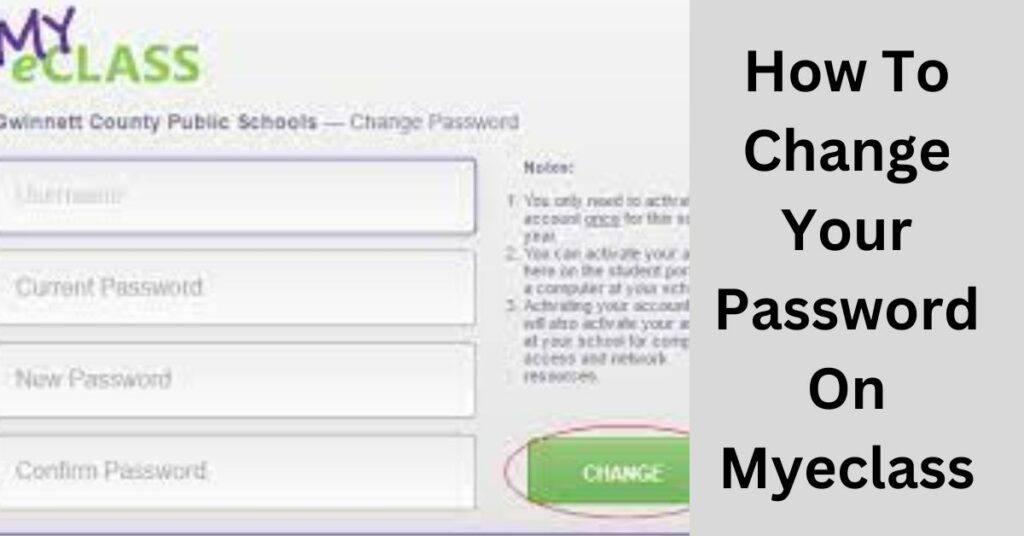How To Change Your Password On Myeclass? – Step By Step

MyEclass is a valuable platform used by students and educators alike for online learning and course management.
To ensure the security of your account and personal information, it’s important to change your password regularly.
This article will guide you through the process of changing your password on MyEclass.
Table of Contents
Step 1: Log In to Your MyEclass Account:
Before you can change your password, you must first log in to your MyEclass account. Visit the MyEclass website and enter your username and current password.

Step 2: Access Account Settings:
Once you are logged in, navigate to your account settings. You can usually find this option by clicking on your profile picture or name in the upper right-hand corner of the screen. A dropdown menu will appear, and you should select “Account Settings” or a similar option.
Step 3: Locate the Password Change Section:
In the account settings, look for a section related to changing your password. This section may be labeled as “Change Password,” “Password Settings,” or something similar.
Step 4: Verify Your Identity:
To ensure the security of your account, MyEclass will typically require you to verify your identity before changing your password. You may need to enter your current password again or answer security questions.
Step 5: Create a New Password:
Once your identity is verified, you can proceed to create a new password. Follow these guidelines when creating a strong password:

Make it at least 8-12 characters long:
- Use a mix of upper and lower case letters.
- Include numbers and special characters (e.g., !, @, #, $).
- Avoid using easily guessable information, such as birthdays or common words.
Step 6: Confirm the New Password:
After entering your new password, you will usually be asked to confirm it by typing it in again. Make sure both entries match exactly to avoid any login issues later on.
Step 7: Save Changes:
Once you have successfully created and confirmed your new password, don’t forget to save the changes. There is often a “Save” or “Update” button at the bottom of the password change section. Click on it to apply your new password.

Step 8: Log Out and Log Back In:
To ensure your new password is working correctly, log out of your MyEclass account and then log back in using your new credentials. This will confirm that the password change was successful.
Password Security Best Practices:
When changing your password on MyEclass or any other online platform, it’s important to follow best practices to enhance your account’s security. This section will provide you with tips on creating a strong and secure password.

Additionally, it will cover the importance of not sharing your password with others and the benefits of enabling two-factor authentication if the platform offers this feature.
Troubleshooting Password Change Issues:
Sometimes, users may encounter issues while changing their passwords. This section will address common problems that may arise during the password change process, such as forgotten passwords, locked accounts, or error messages. It will provide guidance on how to troubleshoot these issues and regain access to your MyEclass account.
Setting Up Password Recovery Options:
To prevent being locked out of your account in case you forget your password, it’s a good practice to set up password recovery options. This section will explain how to add alternative email addresses or phone numbers to your MyEclass account, which can be used to reset your password if necessary. It’s a proactive step to ensure you can always regain access to your account.
Changing Your Password Periodically:
Regularly changing your password is essential for maintaining the security of your MyEclass account. In this section, you will learn about the importance of changing your password periodically and how to establish a routine for doing so. We’ll also provide advice on keeping track of your password changes and ensuring that your new passwords are unique and strong.
Password Change Notification and Alerts:
Keeping track of changes made to your MyEclass account, including password changes, is crucial for security. In this section, we’ll discuss how you can set up notifications and alerts to be informed whenever a password change occurs on your account. This feature helps you stay vigilant against unauthorized access and ensures you are promptly aware of any account activity.
Password Managers for Enhanced Security:
For users who struggle with remembering complex passwords or want to ensure the utmost security, password managers can be a valuable tool.
This section will introduce you to password managers, explain how they work, and provide step-by-step instructions on integrating a password manager with your MyEclass account.

Password managers can generate and store strong, unique passwords for each of your online accounts, making it easier to maintain strong security practices.
Educating Others on Password Security:
Promoting password security isn’t just about safeguarding your own account; it’s also about creating a secure environment for your fellow users. In this section, we’ll discuss the importance of educating others, such as classmates or colleagues, about password security.
You’ll learn how to share best practices with your peers to collectively strengthen the security of your MyEclass community. Additionally, we’ll provide tips on conducting password security workshops or presentations to raise awareness.
Conclusion:
Changing your password on MyEclass is a straightforward process that helps protect your account from unauthorized access. By following the steps outlined in this article, you can easily update your password and ensure the security of your online learning experience. Remember to choose a strong and unique password to further enhance your account’s security.


